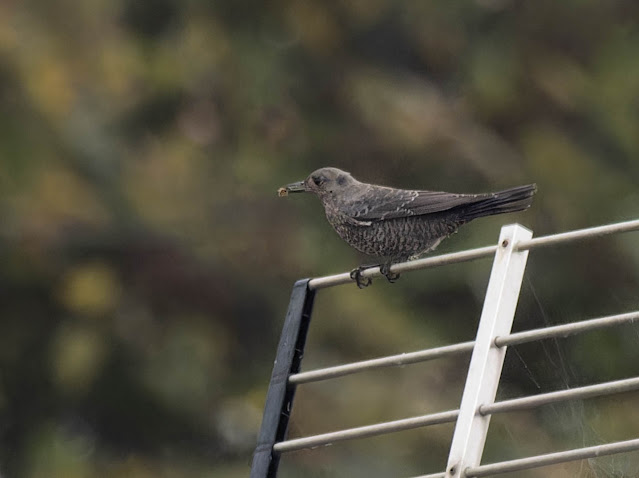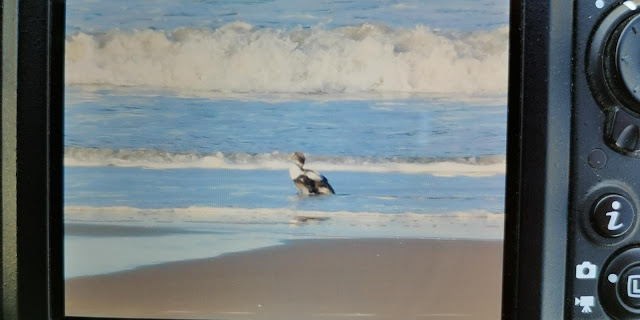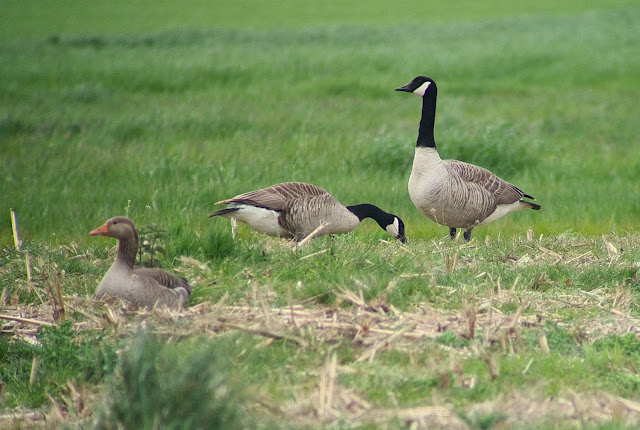Welcome
Saturday, 6 May 2023
Friday, 5 May 2023
4 May 2023 - Ruff Day!
Monday, 21 November 2022
Finding a Blue Rock Thrush at Winterton on October 20th 2022
 |
| The WhatsApp messages 😂 |
 |
| The second sighting - phew! |
Thursday, 9 June 2022
May 2022 Roundup
I've been finding it harder and harder to write these monthly roundups. In large part this is because what I really most enjoy about patch birding is not the occasional rarity that I might be lucky enough to find, but the activities and movements of the more 'common' species on the patch, the arrivals and departures of the winter and summer visitors and the birds passing through on their way to or from their breeding grounds, the first Wheatear of the year, the last Redwing, the Stonechat and Linnet broods, the annual spring appearance of Avocets on the distant pool in the north of the patch.
But these days for patch birders on the east Norfolk coast a retrospective look back at the month just gone by almost inevitably invokes disappointment in comparison with the hopes we all had at the start of the month. For lifelong birders, May used to be a highlight of the year, with fresh spring migrants pouring in, breeding birds setting up territories, the dawn chorus, and for me most magical of all: the arrival of the Swifts which, as Ted Hughes put it, 'means the globe's still working'.
But the tragic truth is that the globe's struggling, more and more each year and each month. The Mays of our youth will never come back, and today we are reduced to simply bearing witness to the ever decreasing numbers of birds in ever more impoverished habitats, and scrabbling around to glean our birding pleasures from more and more infrequent sightings of once common migrants. The truth is, with a handful of exceptions, there are no common migrants any more, and watching the few pairs of Swallows or Willow Warblers that remain on the patch is a pleasure completely suffused with huge sadness at the losses such species have sustained, and their inevitable continuing decline. Finding something on the patch like a Spotted Flycatcher or a Yellow Wagtail is now one of the highlights of my birding week, rather than a welcome but expected occurrence. And after witnessing the awful die-off of auks last winter, as I write it now seems like avian flu is here, with carcasses of Gannets washing up on the beach.
The other day someone I follow on Twitter encapsulated how I increasingly feel in a series of tweets which I've put together below:
Sorry to sound like an eeyore but recently I've been struggling to derive much pleasure from local birding, as I feel like I'm witnessing extinction/biodiversity collapse in real time. I can literally see the gradual disappearance of, say, Marsh Tit, Yellow Wag, Yellowhammer. Meanwhile, the likes of Wood Warbler, Willow Tit, Turtle Dove, probably LSW, have already disappeared, This grim reality is hard to ignore when out birding. It's also the reason I find the "yay, aren't birds brilliant" vibe of "nature twitter" and the "nice one mate, Eleanora's on my fucking list" vibe of twitching twitter so jarring: they feel like inconsequential scraps of pleasure amidst a biosphere going to shit. Tbh I think this is only hitting me now as I've led a rather itinerant existence as an adult (living, variously, in Fife, London, Essex, Leeds and now Cov), and only now have I been doing regular local birding long enough to properly notice real time biodiversity collapse. I can't help feeling that folks who have been local patching for longer than I have must have either greater emotional resilience than I possess, or some serious capacity for compartmentalisation.And I remain more convinced than ever that the nature conservation sector is wholly inadequate to the task of combatting biodiversity loss: it is risk averse and apolitical at a time when - as I argue here: - we need angry radicalism.
@JDeanbirding
I'm now not sure my emotional resilience is strong enough to continue documenting this decline month by month, so it's possible that this monthly roundup could be my last. However, who knows? Maybe I'll find some positivity down the back of the sofa and be able to continue. It hasn't all been bad this last month - the good numbers of Ring Ouzels continued into May, and our pioneering, if slightly dubious, approach to extreme long-range birding of the Horsey area with telescopes from Bramble Gap continued to produce some unusual records for our Winterton year lists! So I'm definitely not yet saying never again with the roundups, but if this is the last one, you can always look at the tweets on the right (desktop version of the blog - dunno where they are on the mobile version) if you want to flick back and see what's been seen here lately.
The month began with a bang for our regular visiting birder Stuart W, who saw a Red-rumped Swallow go south at Bramble Gap on the morning of the 1st. Ring Ouzels were still around, with several in the paddocks, and Chris, another of our regular visitors, heard the first Cuckoo of the year from the Commissioners area on the same day. The Cattle Egrets remained amongst the newly arrived cows in the fields inland from Bramble Gap, and the first Hobbies of the year returned to the Mill Farm area, and a Reed Warbler was singing near the Coot Pool.
Our newly appointed warden for the North Dunes National Nature Reserve, David B, reported hearing a Grasshopper Warbler in the Warren over several days at the start of the month, but despite many attempts none of the rest of us managed to hear it (but then our average collective age puts us at a distinct disadvantage in this respect!).
On the 2nd Chris was scanning the lovely flock of summer plumage Golden Plovers which had been hanging around in the newly ploughed maize patch along the Holmes Road when into his scope view popped one of the star birds of the month - a Shorelark, which, although always very distant in the field, remained for long enough for most of us to see it. Photos were difficult, and Maynard's digiscoped image is about as good as it gets I'm afraid!
Maynard continued to demonstrate his photography skills with this shot of an ultra-rare-these-days Grey Partridge which he found near the old maize patch on the hedge footpath between the concrete track and the Holmes Road.
Barry found a Yellow Wagtail in the Edward Road paddock which, again, remained for much of the day, although it took some of us several visits to manage to see it. When it did appear it it was usually out of range for decent photographs, as the evidence below shows! Some parts of north Norfolk were at this time recording double figure flocks of Yellow Wags, something which we have not seen here for some years - we just get ones and twos these days, plus a few more non-stopping flyovers.
On the 18th there were still at least 2 Spotted Flycatchers and a Reed Warbler in the valley. Colin, enjoying a coffee in his garden and playing around with the new Merlin bird sounds identifier, almost spat his beverage all over his phone when "Bee-eater" suddenly popped up on the app. He leapt up and frantically searched the skies and listened with his own ears, but alas it was not to be. Given that the app later also found a "Moustached Warbler" in the dunes, it seems we must take its claims with a huge amount of seasoning! That afternoon there were 6 Wheatears between the village and the car park, and that evening Pat noticed a pair of Tufted Duck on Commissioner's Dyke. They remained on the dyke over the next few days, always extremely unobtrusive and difficult to see except in the evenings.
Sunday, 8 May 2022
April 2022 Roundup
Not a lot of time this month so here is a simple list of the highlights from resident and visiting birders. If I find time I'll come back to it and add some 'flavour'.
Red Kites and Bar-tailed Godwits were seen regularly throughout the month and the commoner warblers began to appear in slightly better numbers. The first records are mentioned here.
1st - 3rd: 2nd winter Glaucous Gull
3rd: Redshank, Green Woodpecker
4th: Black Redstart
6th: Willow Warbler
11th: Ring Ouzel (they were regular throughout the month from this date, sometimes in really good numbers), White Wagtail, Swallow
12th: Sand Martin, Tree Pipit, Barnacle Goose, Black Redstart, 7 Whimbrel (regular after this date)
13th: Black Kite, male Hen Harrier
14th: House Martin, male Redstart, Sedge Warblers, 5 Brambling
15th: female Hen Harrier (seen over the rest of the month), 3 Brent Geese, 12 Golden Plover, Little Ringed Plover
16th: Woodlark, 2 Shoveler
17th: 5 Gadwall, Short-eared Owl, Jack Snipe
19th: Fulmar
20th: Lesser Whitethroat
23rd: 2 Turtle Doves north
25th: Arctic Terns, Common Terns, 3 Bitterns (distantly inland from Bramble Gap), 2 Canada Geese
27th: 3 Great Egrets, 3 Cattle Egrets (first for the patch), Whinchat
28th: Wryneck
30th: Garden Warbler


.jpg)












.jpeg)






.jpeg)






.jpeg)
.jpeg)
.jpeg)

.jpeg)
.jpeg)
.jpeg)















